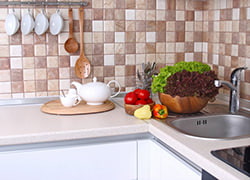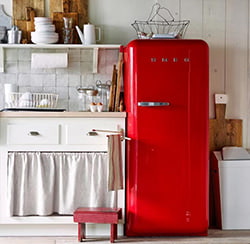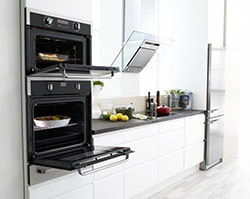Council. The quality of cleaning will not improve if you use the most expensive detergents and cleaning products. In some cases, simple home remedies that are cheap and not harmful to your health are much better.
Surfaces
What is the best way to start cleaning the kitchen? Perhaps, from the most difficult and "dirty" job - scrubbing the apron, kitchen tiles, facades and countertops.

- Tiles and other ceramic surfaces regular soda wipes well. It is moistened with water to a pasty state, and applied to surfaces requiring cleaning. Soda breaks down grease stains perfectly. After a while, the surfaces are washed with water.
- Kitchen facadesthat may have stains and dirty smudges can be washed well with ordinary laundry soap.
Kitchen cleaning tips would be incomplete without considering cleaning methods for different types of countertops.
- Wooden table top. If the material of the countertop is wood, it must be coated with oil (for example, linseed) to protect it from contamination. Clean wooden countertops with coarse salt or baking soda.
- Stone countertops wash with soapy water, and never use abrasives.
- Granite countertops cannot be washed with substances that have an acidic reaction (vinegar), they are washed with dishwashing detergents with the addition of alcohol in a ratio of 3: 1, diluting this mixture with water.
Council.Before starting the general cleaning of the kitchen, unplug the refrigerator and prepare it for defrosting. Also, wet the stove with soapy water or dishwashing detergent solution and leave it on for a while. Grease and dirt will go away, at the end of cleaning you just have to wipe it with a dry cloth.
Refrigerator
Once a week, it is necessary to revise the contents of the refrigerator. By the time you have finished cleaning the surfaces, the refrigerator has already “thawed out” and you can start disassembling it.
-
 First, take out and inspect the food. Those that have expired or have changed their appearance should be thrown away.
First, take out and inspect the food. Those that have expired or have changed their appearance should be thrown away. - Remove shelves, plastic fruit containers and other containers and wash them with soap or dish soap.
- Cleaning the kitchen will require ammonia: it perfectly cleans old stains on the plastic of the refrigerator, and will also help wash glass shelves to shine - just add a few drops of ammonia to the water you will rinse them with.
- Soda, soap, dish detergent will help to cope with grease stains in the refrigerator. Do not use aggressive detergents containing chlorine or triclosan. You can try whitening yellow spots with toothpaste.
- After washing, everything that goes into the internal equipment of the refrigerator must be thoroughly dried and returned to its place.
Council. If there is an unpleasant smell in the refrigerator, place a container with freshly ground coffee in it. Silica gel bags remove the smell well (these are put into shoe boxes).
Oven, microwave
In a modern kitchen there are usually two “ovens” - a microwave and an electric or gas oven. All kitchen cleaning tips usually point out that it is very difficult to clean them, but in fact this is not entirely true if you follow a simple scheme.
 Read the instructions for the oven.Perhaps she has there is a cleaning function, pyrolytic or catalytic. If this is the case, then you hardly have to do anything.
Read the instructions for the oven.Perhaps she has there is a cleaning function, pyrolytic or catalytic. If this is the case, then you hardly have to do anything.
- With pyrolytic cleaning, you just need to turn on the oven in the appropriate mode, and all the dirt will turn into ash, which can be removed with a damp cloth.
- With pyrolytic cleaning, the entire cleaning consists in rinsing the walls with soapy water.
If in your oven no special cleaning functions, general cleaning of the kitchen will take a little longer.
- Dilute four tablespoons of baking soda in 0.5 liters of water, pour this solution into a spray bottle and spray the walls of the oven.
- Let it sit for an hour, then rinse with water.
- If there are dirty spots, repeat the procedure
- In particularly difficult cases, a rubber scraper for car windows can help.
- At the very end, wipe the walls with water and vinegar (1: 1).
The easiest part of cleaning the kitchen is washing the microwave.
- Take a microwave-safe bowl, pour a glass of water into it and squeeze the juice of one lemon, or dilute two teaspoons of citric acid in it.
- Place the bowl with the solution inside and turn on the oven for 10 minutes at maximum power.
- Gently remove the bowl and wipe the walls of the microwave with a dry cloth.
Council. The first thing to do when starting to clean the stove is to remove the baking sheets and grates from it, and soak them in a deep container of hot water, adding a little liquid for the dishes to it. After half an hour, they can be easily cleaned with a sponge.
Dust
Cleaning in the kitchen includes wiping all surfaces from dust - shelves, jars of supplies, vessels with oil and spices, chandeliers, shades, top surfaces of cabinets, hoods - all this accumulates dust, which also mixes with the settling fat, and remove its not so easy.
Among the useful tips for cleaning the kitchen, one of the most important is not to leave “missing” places! Wipe absolutely all surfaces with a damp cloth: window slopes and window sills, window frames, walls and ceilings.
-
 We remove ordinary dust with a damp cloth, it is better if it is made of microfiber - such a fabric has many microscopic "hooks" that cling to dirt deposits and perfectly remove them from various surfaces.
We remove ordinary dust with a damp cloth, it is better if it is made of microfiber - such a fabric has many microscopic "hooks" that cling to dirt deposits and perfectly remove them from various surfaces. - Where dust has mixed with grease, the rag will have to be moistened with soapy water.
- Metal surfaces, such as a cooker hood, can be easily cleaned with vinegar diluted in water. The filters must be removed from the hood and washed in the dishwasher or in the sink with a dishwashing detergent.
- Remember to clean the blinds: they can be removed and washed with warm water and soap or dishwashing liquid.
Council. Living plants help fight dust and grease in the kitchen by absorbing them. But this will not completely free you from cleaning, because the green leaves of plants also need to be cleaned of accumulated dust. But plants perfectly clean the air from the combustion products of household gas, which is important for kitchens with gas stoves.
Washing
- In order not to waste time and energy on washing the sink, close it with a stopper, fill it with hot water to the top, and add a little bleach to the water.
- After an hour, drain the water, and wipe the sink with a sponge, to which a couple of drops of dish soap have been applied.
- The mixer can be wiped with diluted vinegar or lemon juice to remove limescale.
- Wipe the faucet and sink dry after washing.


 10 practical tips for arranging a small kitchen in the country
10 practical tips for arranging a small kitchen in the country
 12 simple ideas for a small garden that will make it visually spacious
12 simple ideas for a small garden that will make it visually spacious

 How to choose the color of your kitchen sink?
How to choose the color of your kitchen sink? White kitchen set: features of choice, combination, 70 photos in the interior
White kitchen set: features of choice, combination, 70 photos in the interior Black set in the interior in the kitchen: design, choice of wallpaper, 90 photos
Black set in the interior in the kitchen: design, choice of wallpaper, 90 photos How to choose curtains for the kitchen and not regret it? - we understand all the nuances
How to choose curtains for the kitchen and not regret it? - we understand all the nuances Design of a white kitchen with a black countertop: 80 best ideas, photos in the interior
Design of a white kitchen with a black countertop: 80 best ideas, photos in the interior Kitchen design with green wallpaper: 55 modern photos in the interior
Kitchen design with green wallpaper: 55 modern photos in the interior